
Features
Crop Culture
Inputs
Growing in the Green: Heading into the home stretch
November 3, 2008 By Melhem Sawaya
Keep records of everything done with your crop culturally, and record “ready” dates rather than “shipped” dates
Keep records of everything done with your crop culturally, and record “ready” dates rather than “shipped” dates
This is the month (October) when a poinsettia crop can turn from “great” to “fair,” or to “bad,” or a “poor” crop can be improved to be “great.” Here are some points to remember at this time in the crop cycle.
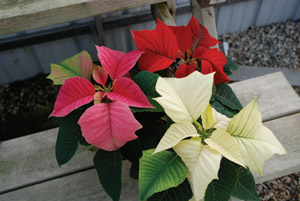
The Enduring series is a good tricolour combination, especially when not pinched.
|
- If you haven’t checked your soil EC and pH, the time is well overdue. It is an excellent idea to check them every two weeks.
Be aware of your phosphorous levels; they should be between 10 to 15 ppm. Much of the literature on poinsettia growing suggests growers use very low levels of phosphorous, but this could lead to total depletion of it. The bottom leaves will turn yellow and the whole plant will look chlorotic if the deficiency is severe.
At the same time, monitor your pH levels and keep them in the optimal range of 5.8 to 6.2. If the pH is out of the range, use the proper fertilizer to adjust the levels upwards or downwards. Use fertilizers that indicate potential acidity to lower pH, and fertilizers that indicate potential alkalinity to raise pH.
- The plants’ potential frequency starts to decrease in October. Therefore, an increase in fertilizer levels is recommended to avoid stretch and maintain good quality. Weekly or biweekly EC and pH tests will keep you on track.
TEMPERATURES EFFECTIVE CROP MANAGEMENT TOOLS
- Temperature is the only thing we can control in growing poinsettias. It is the time of the year when simple, minor venting will cool the greenhouse during the day, while at night we can heat to the desired temperature. There’s been a lot written about growing poinsettias cool. It is indeed a “cool” idea for those growers who have tried it before and know their limits in how far to drop the temperature, and at what stage.
Here are a few suggestions:
- If you did not start your crop with an earlier schedule than you normally do, then there isn’t much room to drop the temperature more than you normally do.
- If you started the crop earlier than you normally do but you didn’t start short days earlier than you normally do with the use of blackout, then any significant temperature drop in October and November could lead to missing your sales date, or it could result in inferior bract quality.
- Know your varieties; some need only seven weeks of short days to flower, while others need nine at normal temperatures of 20-22ºC. If a variety needs eight to nine weeks at 20-22ºC to flower, it would need another week if the temperature dropped to 17-18ºC. And if the temperatures are dropped to 14-15ºC, then at least two to three weeks will be added to the flowering and bract colouring process.
- Lowering the temperature without the capability of dropping the humidity to 70 to 75 per cent is a recipe for Botrytis, which could result in an inferior crop. It may not be shippable. And if it is shipped with Botrytis, the spores will flourish during shipping or at the store level.
- Dropping temperatures could encourage Pythium root disease if the plants stay wet for a long period of time and in cold temperatures.
All chemical growth regulators are more effective at cooler temperatures. Changing the temperature practice will require an adjustment in the rates and frequencies of growth regulator applications.
Normally if a plant is grown cool and on the moist side, problems will develop when it reaches the much warmer conditions in a store.
By no means am I trying to imply that growing poinsettias at moderately lower temperatures is not a good idea. On the contrary, it is an excellent idea; however, the grower has to know all the parameters and not just be content in turning down the thermostat!
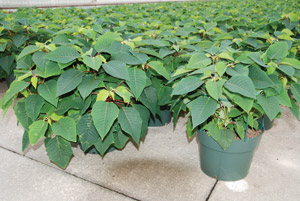
Poinsettia ring just put on, compared to poinsettia without ring.
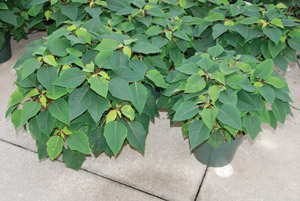
Poinsettia ring put on three weeks ago, compared to poinsettia without ring. 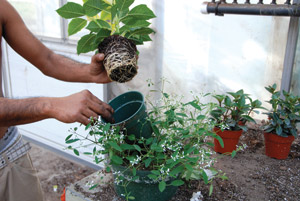
Diamond Frost and a poinsettia grown separately, and then put together.
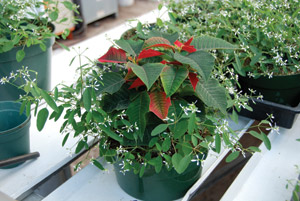
Poinsettia and Diamond Frost combination. |
PGR APPLICATION ESSENTIAL FOR GOOD CROP QUALITY
The application of growth regulators, when applied properly, is essential for ensuring good crop quality. Here are some suggestions to optimize their usage.
Lightly spraying the crop with Cycocel at 1,000 ppm in the early stages of 2.5 cm break lengths is an excellent way to keep the crop even. Increasing the volume will control the height, so using the same concentration at different volume levels can change the outcome. Light sprays are quite fine, so that only the larger breaks catch the spray and this will even out the crop. When the majority of breaks are in the 5 to 7 cm range, then increase the volume so that you can have height control if desired or needed.
Never spray B-Nine within two to three weeks of short days, because this will drastically delay flowering, especially in northern regions.
Spraying Sumagic or Bonzi at any concentration is not a good idea at early stages because they may make the crop uneven. When you look at the crop after spraying, it might look all at one level, but the idea is to get the breaks on the pots even, not have the whole bench as one level. We ship individual pots and not the whole bench as one unit. In my experience, spraying with these products at a later stage will delay bract development significantly, and you might miss a selling date. In short, never spray Sumagic or Bonzi on poinsettias at any rate! However, applying them in low levels as drenches is beneficial when applied properly. When used as drenches, these chemicals don’t show their effects until four days after the application date. They also have a long lasting effect, so avoid multiple applications especially if the crops are grown cool. Try them on a small number of plants and keep records to compare with control plants. In this way, you can judge the level of control and see if the treatment is desirable or whether it needs to be adjusted.
Different cultivars react differently to similar concentrations and volumes of any growth regulator. Even some very vigorous varieties will respond well to such treatments.
Generally avoid any spray growth regulator treatment two weeks after the start of short days, and avoid drenches three weeks after the start of short days. In some cases, we can drench with very low rates past the three weeks, but do it only if you have tried it before and you know all that is needed and the exact outcome.
Make sure all your equipment is calibrated. This is especially important when drenching, because we are using low concentrations, and miscalculations could be magnified 100 times.
POINSETTIA NUMBERS DOWN AGAIN THIS YEAR
The number of poinsettias grown in Canada is down by another 10 per cent this year. In the U.S., it’s down by 30 per cent. But don’t kid yourself; the number of pots being grown is more than enough to meet the demand.
If you didn’t increase your prices by 15 to 20 per cent from last year’s prices, your net margin is at least that much lower than last year if everything else is equal. But the costs of energy, labour, fertilizers, chemicals and containers have all increased significantly.
Do yourself a favour, and don’t ever colour a poinsettia. It is a recipe to cut shelf life by 80 per cent at the least, possibly 100 per cent in the worst cases!
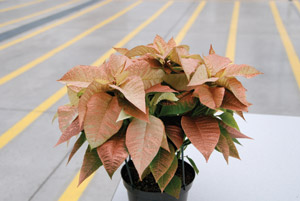
That is how James Bond nemesis Goldfinger killed people! We are doing the same thing with plants by plating them with gold spray.
|
If you are growing poinsettias with Diamond Frost, pay attention because Diamond Frost cannot take many of the growth regulators we use. (And for me, this is not a friendly houseplant combination, unless you supply a vacuum cleaner with every purchase!)
Sell plants that are consumer tested and have good shelf life. If the customer is not happy, he or she might never buy a poinsettia again.
Keep records of everything you do with your crop culturally. Record “ready” dates rather than “shipped” dates for each cultivar. Be accurate in recording all temperature and other treatments. This way, if you are happy with your crop, you can repeat your success next year. If you weren’t happy, you will know what to adjust.
Melhem Sawaya of Focus Greenhouse Management is a consultant and research coordinator to the horticultural industry. Comments on this or any other article are always welcome by e-mailing him at focussawaya@kwic.com.
Print this page